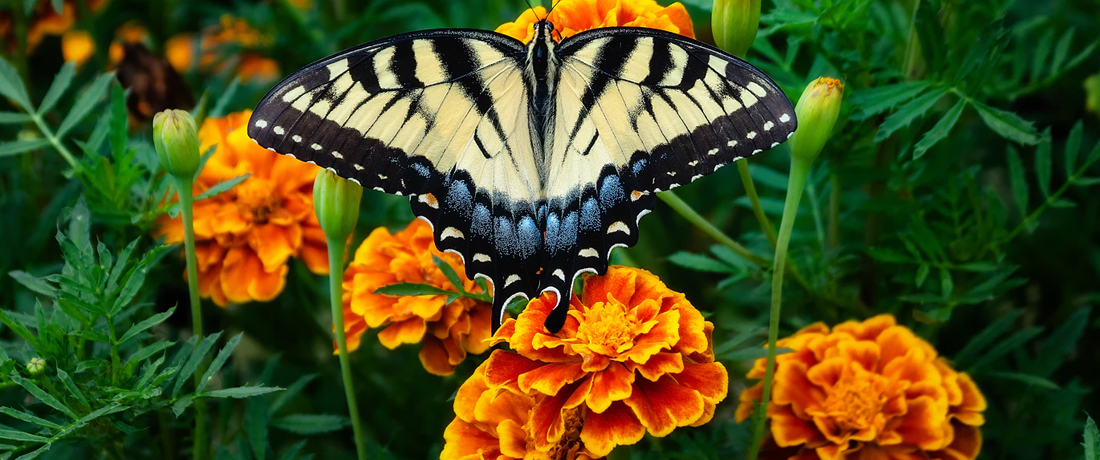
Don’t forget the birds, butterflies and bees! Provide a feast for them in your garden with a range of natives that are flowering now. It’s a fantastic time to appreciate the floral splendor of the Australian bush, whether the delicate blossom of a Hypocalymma or the robust bud of an Isopogen.
Attracting Butterflies To Your Garden
Butterflies and moths have suffered habitat loss particularly through the removal of native grasslands. These creatures not only add colour and beauty to your garden, they are important pollinators for many plants. Butterflies require nectar-producing plants for their food source and host food plants for their caterpillars.
Butterflies, active during the day, particularly like daisy-type flowers, which provide a landing platform for them whilst feeding. Moths, active during the evening, are attracted to cream and white flowers, which are visible at dusk and often fragrant.
The plants that butterflies and moths feed on at the larval (caterpillar) stage of their life cycle are not permanently damaged and plants often benefit from the tip pruning by these creatures.
Butterflies are not attracted to gardens where plants are continually pruned and sprayed as these practices kill caterpillars and remove the eggs that the butterflies have laid on the foliage. Butterfly attracting gardens are relaxed gardens that require minimal maintenance. It is very important if you wish to attract butterflies to your garden, that you try to reduce any chemical sprays to a minimum, or do not spray at all.
Butterflies tend to lay their eggs on plants with smooth foliage. You will sometimes see the eggs suspended on the end of a thread off the leaf surface, and sometimes laid in neat rows on the leaf surface.
Butterfly attracting gardens will provide both food sources and host plants. It is also a good idea to provide a fresh source of water, however this does not have to be large. A mixture of plants including native grasses, daisies and plants with small tubular flowers usually in pale colours will attract butterflies. Also leave an area of cleared mulched ground, with some rocks to provide a sunny resting spot during the day.
Plants For Butterflies
Here is just a small selection of butterfly attracting plants.
Brachyscome Food source and resting spot (Groundcover)
Bursaria spinosa Food source and egg laying (Shrub)
Clematis microphylla Food source (Shrub)
Spyridium Food source (Shrub)
Arthropdium strictum Food source (Lily)
Goodenia ovata Food source and shelter (Shrubs and groundcovers)
Poa spp. Food source and shelter (Grass)
Themeda triandra Food source and shelter (Grass)
Austrodanthonia spp. Food source and shelter (Grass)
Chrysocephalum (Helichrysum) Food source and shelter (Groundcover)
Calytrix tetragona Food source and shelter (Shrub)
Lomandra spp. Egg laying (Grass)
Stylidium graminifolium Food source (Grass)
Xanthorrhoea spp. Food source and resting spot (Grass)
Pimelea spp. Food source (Shrub)
Attracting Birds to your Garden
Birds have three main requirements for survival in any habitat: water, shelter and food. Water should be provided year-round for bathing and drinking. Bird baths, ponds or water features can supply this but they must be inaccessible to cats, or situate them in an open area where the birds can see if a predator is approaching. Clean out bird baths regularly to provide fresh drinking and bathing water.
Dense shrubberies provide birds with shelter, protection from predators and for nesting. Dense and prickly foliaged shrubs, and trees with hollows (both dead and living trees), provide nesting sites for birds. Many birds and other small mammals use hollows in dead trees for nesting and shelter. Therefore, it is best to assess wether or not you need to remove dead trees, otherwise simply leave them where they are.
Food is best supplied by planting nectar and seed producing trees, shrubs and grasses, which provide seasonal sustenance to birds. Try to provide different food sources, not just nectar, so that a range of bird species are attracted to your garden. Some birds will feed high up in the trees, and some will feed on the ground.
Bird feeders can be used to supplement other natural sources, however remember that if you feed birds on a
regular basis, they may become dependant on this food source. When you go on holiday or move, this food source is removed and some birds may starve. It is far better to provide an environment where birds can nest, breed and feed in your garden by providing the right environment and plants.
Plants For Birds
The following is a tiny selection of plants that may be used to attract birds to the garden.
Acacia: Food source and nesting site (Trees and shrubs)
Alogyne: Nectar source (Shrub)
Anigozanthos: Nectar source (Grass)
Banksia: Nectar, seed source and nesting site (Trees, shrubs and groundcovers)
Callistemon: Nectar and seed source (Trees and shrubs)
Correa: Nectar source (Shrub)
Calytrix: Nectar and shelter (Shrub)
Epacris: Nectar and shelter (Shrub)
Eucalyptus: Food source and nesting site (Tree)
Hakea: Nectar and seed source (Trees and shrubs)
Kennedia: Nectar and insect source (Climbers and groundcovers)
Melaleuca: Food and nesting site (Trees and shrubs)
Leptospermum: Food and nesting site (Trees and shrubs)
Prostanthera: Insect source (Shrub)
Bursaria: Insect source and shelter (Shrub)
Hibbertia: Insect source (Climbers and groundcovers)
Themeda: Seed source (Grass)
Grevillea: Food source and shelter (Shrubs and groundcovers)
Poa: Seed source (Grass)
